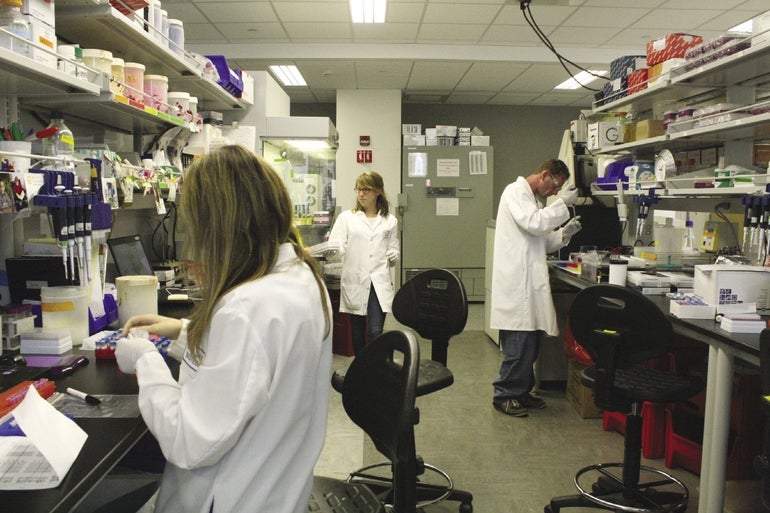Bioscience community defends drug pricing model
Amid growing political and industry pressure to suppress the rising costs of prescription drugs, leaders in the Central Mass. bioscience community said they are willing to discuss compromises but the turmoil could have a cooling effect on a growing market in the region.
“We have to be careful because it isn't just drug pricing. It's the economy,” said Kevin O'Sullivan, president and CEO of the Massachusetts Biomedical Initiative (MBI). “It's a big part especially out here where we have education and life sciences.”
The pressure on drug companies – from startups to major pharmaceutical manufacturers – has primarily come from health insurers and politicians like Massachusetts Attorney General Maura Healey, especially as the Affordable Care Act has put pressure on other players in the healthcare industry, such as doctors and hospitals, to cut costs.
Nationwide spending on prescriptions rose from $121 billion in 2000 to $271 billion in 2013, and the costs are expected to reach $435 billion by 2020, according to The Office of the Actuary in the Centers for Medicare & Medicaid Services.
The fledgling bioscience industry in Central Massachusetts has a lot at stake, O'Sullivan said. The 35 MBI labs in Worcester alone host an average of 125 employees for startup companies. These companies include those conducting contract research and development to startups creating novel software for the industry. Although these companies may not be the ones that ultimately reap the financial benefit from a high-priced novel drug, they are part of the infrastructure that is supported by that high potential payoff.
Without that large payoff, the investment in the life sciences could start to dry up, affecting all levels of the industry, he said.
“The biotech and pharma companies need to have an honest discussion on costs. There's a cost for failure and a cost to develop,” O'Sullivan said. “They need to make their case to the legislature and advocacy groups to prove it.”
Rising costs
The final payoff is not often seen by the companies actually developing the drugs, said Lora Pellegrini, president of the Massachusetts Association of Health Plans, which represents health insurers.
A lot of these drugs are first fostered in incubator situations and then their work gets bought up by the larger companies who had nothing to do with their development right at the time the drug is ready to be brought to market, Pellegrini said. Those larger companies then reap the monetary benefits for years to come.
“They often use federal money to support the research, and then right before they go to market the licenses are often bought by a larger company,” Pellegrini said.
The health insurance industry has been held accountable to cost containment and bringing affordable care to businesses and patients, she said, and the drug companies need to be doing their part.
“It seems the attitude is, 'How much can the market bare, and what can we get away with?'” Pellegrini said. “Drugs are much cheaper in other parts of the world, and I think pharma has a lot to explain for why residents of the U.S. pay so much more for drugs than other parts of the world.”
Attorney General Healey caused a stir when she called out a relatively new hepatitis C drug that costs $84,000 for a full course of treatment. The drug Sovaldi from Gilead Sciences costs $1,000 per pill in the United States and roughly $10 in Egypt and $4 in India.
Healey said her office will be investigating whether the pricing constitutes an unfair trade practice in violation of Massachusetts law.
“Our office has concerns anytime there are significant obstacles in the way of patients getting the medication they need,” said Healey. “We need to balance the costs of research and development while making these life-saving drugs more accessible to people.”
A number of drug companies were asked to comment for this story, but they all declined to speak on the record.
Industry impacts
Robert Coughlin, the president and CEO of the Massachusetts Biotechnology Council that represents the life sciences industry in the state, is concerned that these kinds of discussions over pricing, and possible restrictions on the pricing for novel drugs, could stifle a growing industry in Massachusetts.
The payers need to understand that the true price for these drugs can't be calculated in the same way as pills that get rid of symptoms, Coughlin said.
“We're not making me-too drugs. We're looking at cures for diseases,” Coughlin said.
Those cures bring with them a cost, he said, but at a cost that is far less than the long-term prospects of treating someone with a disease.
The drug companies are in the process of developing and have developed true treatments for conditions that lead to no care being needed in the future, Coughlin said.. However, the current system of care can't account for this.
Any government oversight of the pricing would only serve to stifle the investments being made by companies into these treatments, he said.
While Pellegrini is concerned with the actual climbing cost of drugs, her sights are set on a very simple first measure: transparency. The organization is currently pushing for more transparency at the state level through a prescription drug transparency bill that is before the Massachusetts Senate.
If the drug companies open up their process to public and regulatory scrutiny, it would likely drive down prices, she said.
This additional scrutiny is something the drug companies have set themselves up for, O'Sullivan said. For years, companies have been saying that the cost of their drugs comes from the need to reinvest in new products. Now, companies are being called out and asked to show their cards.
“Pharma and biotech cannot curl up in a ball and just say, 'No.' There has to be a joint solution to this problem,” he said. n











0 Comments